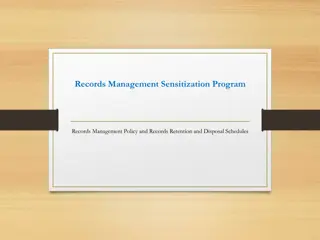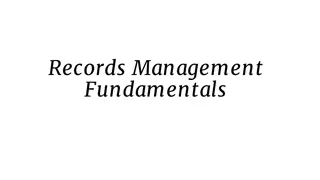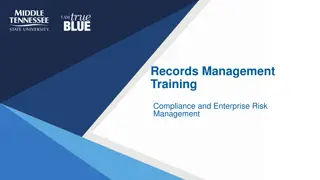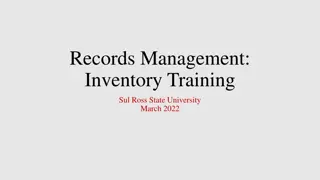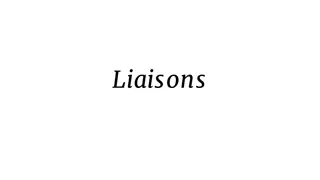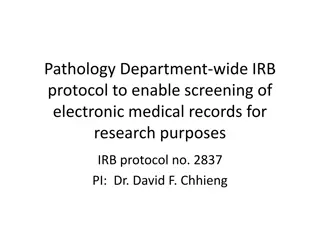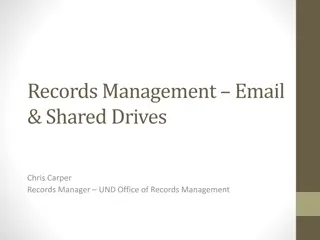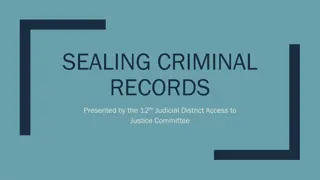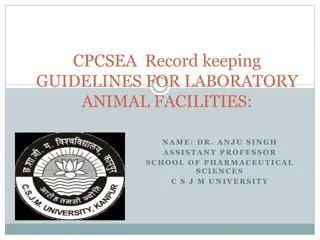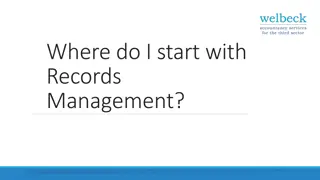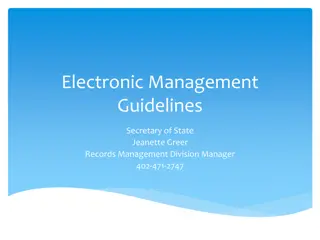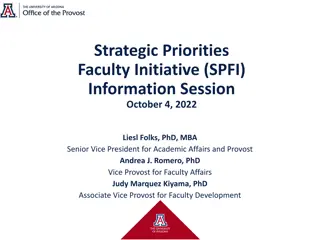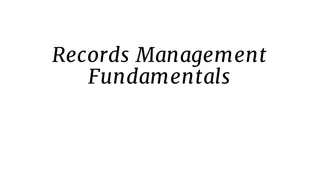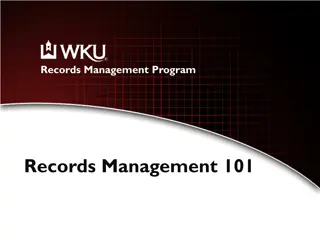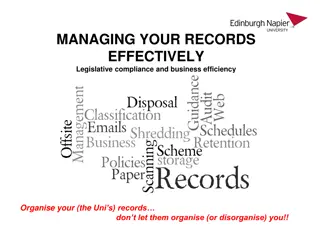Enhancing University Information and Records Management for Strategic Advancement
The University's continuous improvement strategy for 2020 focuses on managing information and records effectively to mitigate risks associated with data processing. Information is deemed a critical asset, and risks range from data breaches to operational disruptions. To address these challenges, an Information Audit is being conducted to identify areas of risk and enhance management procedures. The strategy includes revising Records Management Policy, self-reporting DPA breaches, and implementing stricter sanctions. Collaboration with departments and compliance with ISO27001 standards are key steps in this process.
Download Presentation

Please find below an Image/Link to download the presentation.
The content on the website is provided AS IS for your information and personal use only. It may not be sold, licensed, or shared on other websites without obtaining consent from the author.If you encounter any issues during the download, it is possible that the publisher has removed the file from their server.
You are allowed to download the files provided on this website for personal or commercial use, subject to the condition that they are used lawfully. All files are the property of their respective owners.
The content on the website is provided AS IS for your information and personal use only. It may not be sold, licensed, or shared on other websites without obtaining consent from the author.
E N D
Presentation Transcript
Improving information and records management as part of the University s continuous improvement approach (Strategy 2020).
Risk Strategy 2020 Information Asset
Information is a business asset As a University we are in the information business we process massive amounts of data and information every day. It is the life-blood of the institution essential to our continuing functioning. Information is effectively one of the biggest assets of the University and there are, therefore, a variety of risks associated with its management.
The risks which have to be considered when managing information are diverse from disclosure of personal data in breach of the Data Protection Act (DPA) or retention of information beyond the time limits allowed in breach of the DPA and other legislation, to a loss of information which disrupts business operations or difficulties finding information which costs time, effort and money to retrieve. This can have a damaging impact on the business, causing reputational damage, financial loss, business inefficiency, etc. and it is therefore critical that the University puts measures in place to mitigate against these risks.
In order to ensure that the information and records that the University processes are managed in accordance with best practice procedures and comply with legislation and regulation, Governance Services are conducting an Information Audit. The Information Audit is a risk mitigation exercise and quality improvement process. By understanding what information the University holds and how this is being processed, we can assess where there are areas of risk and put procedures in place for improving the management of our information.
Initial processes for Audit identified Information Audit gathers information Governance Services collate and assess information Appraise Evaluate Gap Analysis Improve Collaborate to improve information & records management procedures. Governance Services work with depts. to identify areas of risk/ for improvement
Strategy 2020 7 years since the last Information Audit Records Management Policy and Strategy urgently require revision New requirement for self reporting of DPA breaches to the ICO and the introduction of stricter sanctions and heavier penalties for breaches Recent departmental restructuring/office moves ISO27001:2013 more stringent requirements in the new standard and frequent audits Preparation for being brought into scope for National Records of Scotland (Public Records (Scotland) Act)
Build Innovation, Enterprise and Citizenship Adopt a continuous improvement/enhancement approach in all that we do Maximise the value of our [information] assets Information and records are received and created by University staff members and representatives to facilitate and support business processes they are inputs and outputs of the University s activities. Ensuring that our information assets are managed correctly corresponds directly with the objectives of Strategy 2020, namely improving the efficiency of business processes. Build Innovation, Enterprise and Citizenship For more information on how the Information Audit will contribute to Strategy 2020 please see: http://staff.napier.ac.uk/services/secretary/governance/Pages/InfoAudit.aspx
Ensure legislative compliance Understand the current situation with regards to information processing/storage in order to: Assess risk and mitigate where the likelihood of a breach of legislation/regulation is higher Develop an Information Asset Register (IAR) and develop/update Records Retention Schedules (RRS)- both of which are compliance assurance tools. Records Retention Schedules are particularly important in that they set out the University s policy for retaining and destroying records, ensuring we are not subject to action for early destruction and undue retention. These give staff confidence that they are retaining information for the correct length of time. Inform the development of a new Records Management Strategy and Records Management Policy, and other policies and procedures to assist with the continual improvement of the management of University information and records. Generally raise awareness of the importance of good information and records management practices, and the requirements and individuals responsibilities in this regard
BUSINESS FUNCTIONS Supported by processes Supported by information and records - which have set procedures including an information asset register, records retention schedule, filing guide (business classification scheme) and naming conventions
To improve the processes used to manage corporate information across the University in line with Strategy 2020, resulting in efficient business processes supported by efficiently managed information and records To ensure your departmental business procedure documents are up to date (if they aren t already) Provide staff members with the tools, knowledge and confidence to manage all the information that they process, including unstructured data (shared drives, SharePoint, email), and transitory records or supporting information which may not necessarily be dealt with in a Records Retention Schedule.
University: Business efficiencies Risk mitigation Staff members: The right information available to the right people at the right time Assurance that information is reliable, secure, authentic, and can be easily found and retrieved for use and re-use. Customers: Confidence that the University takes its responsibilities towards Information Governance and Records Management very seriously and that their data is safe and secure with us
There are 3 stages to the Audit 1) Managers Questionnaire 2) Audit Spreadsheet Records Management Co-ordinators in co- operation with appropriate members of staff 3) All Staff Questionnaire Managers Questionnaire Audit Spreadsheet for completion by All Staff Questionnaire the plan is to make the audit a the plan is to make the audit a manageable manageable task task
one business process at a time one business process at a time
Managers to identify a Records Management Co- ordinator for team/department. Managers to identify the three (3) work processes/activities in their area with the highest level of risk (e.g. collects personal data, generates commercially sensitive information) for the audit to be carried out on. The audit will focus on the information and records for one process at a time. This questionnaire is designed to get an overall feel for the approach to information and records management in the team/department. As information/records should be filed/arranged according to the business activity and retention period the questions lead with this and move onto security, accessibility, procedures, policies (Records Retention Schedules), training, awareness and responsibilities. It isn t possible to interview each manager individually to complete the questionnaire, but group meetings can easily be arranged. Diana Watt and Helen Mizen are happy to answer any questions. (Feedback: working through the questionnaire was a useful learning opportunity ) (Feedback: working through the questionnaire was a useful learning opportunity )
One spreadsheet to be completed per business process/activity. Starting with the business process which is supported by information which is considered high risk or business critical e.g. personal data, confidential or commercially sensitive data (please see Information Security Classification Scheme for guidance) Ideally this should be completed by Records Management Co-ordinators (or member of staff nominated by the manager) in conjunction with the members of staff dealing with information/involved in working on that specific business process. Following the business process through from beginning to end and documenting the information/records received or created in the course of the process, then completing the rest of the form.
In order to make the task more manageable, identify the work activity/process with the highest level of information risk generates sensitive/confidential information/records) in each team/area and start working on the spreadsheet for that, then move on to activity/process with next highest level of risk First spreadsheets to be completed by the end of 2014 Involve members of staff working on the process/es to identify what information is collected/created in the course of working on this process (working documents/information and records), where and how this is stored, who has access and how long it is/should be retained for highest level of information risk (e.g. collects personal data,
This is a brief questionnaire comprising 7 questions which is designed to raise awareness of information and records management To be completed online To be disseminated by managers (link to online survey emailed to team members) Feedback (anonymous) to be used to flag areas of concern to managers
If you have any process improvement work being done as part of the Improving Operational Processes and Procedures project it would be a good opportunity to conduct the Information Audit at the same time.
Please contact Governance Services, either Diana Watt Governance Officer (Records Manager) D.Watt@napier.ac.uk (extension 6257) or Helen Mizen Governance Officer (Data Protection & Legal) H.Mizen@napier.ac.uk (extension 6359) or check the intranet for further information and updates: http://staff.napier.ac.uk/services/secretary/governance/Page s/InfoAudit.aspx



